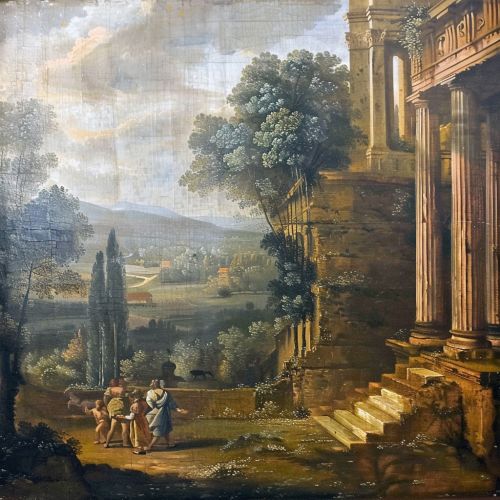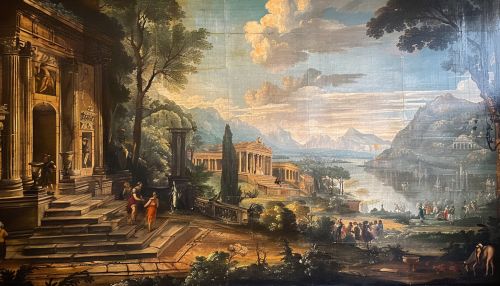Composition in Visual Art: Difference between revisions
(Created page with "== Composition in Visual Art == Composition in visual art refers to the arrangement of elements within a work to create a harmonious and aesthetically pleasing whole. It is a fundamental aspect of art that influences how viewers perceive and interact with the artwork. This article delves into the principles, techniques, and historical context of composition in visual art, providing a comprehensive understanding for both novice and expert readers. <div class='only_on_de...") |
No edit summary |
||
| Line 3: | Line 3: | ||
Composition in visual art refers to the arrangement of elements within a work to create a harmonious and aesthetically pleasing whole. It is a fundamental aspect of art that influences how viewers perceive and interact with the artwork. This article delves into the principles, techniques, and historical context of composition in visual art, providing a comprehensive understanding for both novice and expert readers. | Composition in visual art refers to the arrangement of elements within a work to create a harmonious and aesthetically pleasing whole. It is a fundamental aspect of art that influences how viewers perceive and interact with the artwork. This article delves into the principles, techniques, and historical context of composition in visual art, providing a comprehensive understanding for both novice and expert readers. | ||
[[Image:Detail-91639.jpg|thumb|center|A well-composed painting featuring a balanced arrangement of elements, including figures, landscape, and architectural details.|class=only_on_mobile]] | |||
[[Image:Detail-91640.jpg|thumb|center|A well-composed painting featuring a balanced arrangement of elements, including figures, landscape, and architectural details.|class=only_on_desktop]] | |||
=== Principles of Composition === | === Principles of Composition === | ||
Latest revision as of 08:21, 20 June 2024
Composition in Visual Art
Composition in visual art refers to the arrangement of elements within a work to create a harmonious and aesthetically pleasing whole. It is a fundamental aspect of art that influences how viewers perceive and interact with the artwork. This article delves into the principles, techniques, and historical context of composition in visual art, providing a comprehensive understanding for both novice and expert readers.


Principles of Composition
The principles of composition are the guidelines that artists use to arrange the elements of art in a work. These principles include balance, contrast, emphasis, movement, pattern, rhythm, and unity. Each principle plays a crucial role in the overall effectiveness of the composition.
Balance
Balance refers to the distribution of visual weight within a composition. It can be symmetrical or asymmetrical. Symmetrical balance involves mirroring elements on either side of a central axis, creating a sense of stability and order. Asymmetrical balance, on the other hand, involves arranging elements of different sizes and weights in a way that still achieves a sense of equilibrium.
Contrast
Contrast is the use of opposing elements, such as light and dark, rough and smooth, or large and small, to create visual interest and focal points. High contrast can draw attention to specific areas of the composition, while low contrast can create a more subtle and harmonious effect.
Emphasis
Emphasis involves highlighting a particular area or element within a composition to draw the viewer's attention. This can be achieved through various means, such as contrast, placement, color, and size. The emphasized element often serves as the focal point of the artwork.
Movement
Movement refers to the way a viewer's eye is guided through a composition. Artists use lines, shapes, and colors to create a sense of motion and direct the viewer's gaze from one element to another. This can create a dynamic and engaging experience for the viewer.
Pattern
Pattern involves the repetition of elements within a composition to create a sense of rhythm and structure. Patterns can be regular or irregular and can add texture and depth to the artwork.
Rhythm
Rhythm is the repetition of visual elements in a way that creates a sense of movement and flow. It is closely related to pattern but focuses more on the overall tempo and beat of the composition.
Unity
Unity refers to the cohesion of all the elements within a composition, creating a sense of completeness and harmony. It is achieved through the consistent use of color, shape, texture, and other elements, ensuring that all parts of the artwork work together as a whole.
Techniques of Composition
Artists employ various techniques to achieve effective composition in their work. These techniques include the rule of thirds, the golden ratio, leading lines, framing, and the use of negative space.
Rule of Thirds
The rule of thirds is a compositional guideline that divides an image into nine equal parts by two equally spaced horizontal and vertical lines. The key elements of the composition are placed along these lines or at their intersections, creating a balanced and visually appealing arrangement.
Golden Ratio
The golden ratio is a mathematical ratio, approximately 1:1.618, that has been used in art and architecture for centuries. It is believed to create aesthetically pleasing proportions and can be applied to the arrangement of elements within a composition.
Leading Lines
Leading lines are lines within a composition that guide the viewer's eye towards a focal point. These lines can be actual lines, such as roads or rivers, or implied lines created by the arrangement of elements.
Framing
Framing involves using elements within the composition to create a "frame" around the focal point, drawing attention to it and adding depth to the artwork. This can be achieved through the use of architectural elements, natural features, or other objects.
Negative Space
Negative space, also known as white space, is the area around and between the elements of a composition. It is used to create balance, contrast, and emphasis, and can help to define the positive space (the main elements of the composition).
Historical Context
The principles and techniques of composition have evolved over time, influenced by various art movements and cultural contexts. This section explores the historical development of compositional practices in visual art.
Classical Antiquity
In classical antiquity, artists such as the ancient Greeks and Romans developed compositional techniques based on mathematical principles and ideal proportions. The use of the golden ratio and symmetrical balance were prominent in their work, reflecting their pursuit of harmony and order.
Renaissance
During the Renaissance, artists like Leonardo da Vinci and Raphael further refined compositional techniques, emphasizing the use of perspective, proportion, and balance. The rule of thirds and the golden ratio were commonly employed to create harmonious and realistic compositions.
Baroque
The Baroque period saw a shift towards more dynamic and dramatic compositions. Artists like Caravaggio and Peter Paul Rubens used techniques such as chiaroscuro (the contrast of light and dark) and diagonal lines to create movement and tension within their work.
Modernism
In the modernist era, artists began to experiment with new compositional approaches, breaking away from traditional rules. Movements such as Cubism, led by Pablo Picasso and Georges Braque, introduced fragmented and abstract compositions, while the De Stijl movement, represented by artists like Piet Mondrian, focused on geometric abstraction and the use of primary colors.
Contemporary Art
Contemporary artists continue to explore and challenge traditional compositional techniques, incorporating digital technology and multimedia elements into their work. The principles of composition remain relevant, but artists often reinterpret them in innovative and unconventional ways.
Applications of Composition
The principles and techniques of composition are not limited to traditional visual art forms but are also applied in various other fields, including photography, graphic design, and architecture.
Photography
In photography, composition is crucial for creating visually compelling images. Photographers use techniques such as the rule of thirds, leading lines, and framing to guide the viewer's eye and create a sense of balance and harmony in their shots.
Graphic Design
Graphic designers apply compositional principles to arrange text, images, and other elements within a layout. Effective composition in graphic design ensures that the message is communicated clearly and that the design is visually appealing.
Architecture
Architects use compositional techniques to design buildings and spaces that are both functional and aesthetically pleasing. The principles of balance, proportion, and harmony are essential in creating structures that are visually coherent and structurally sound.
Conclusion
Composition in visual art is a complex and multifaceted discipline that encompasses a wide range of principles and techniques. Understanding and mastering these elements is essential for artists, designers, and architects to create works that are both aesthetically pleasing and effective in communicating their intended message. By studying the historical context and applications of composition, one can gain a deeper appreciation for the art form and its enduring significance.
